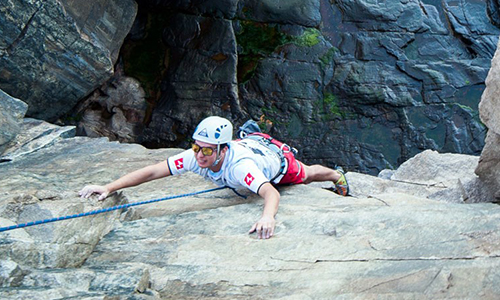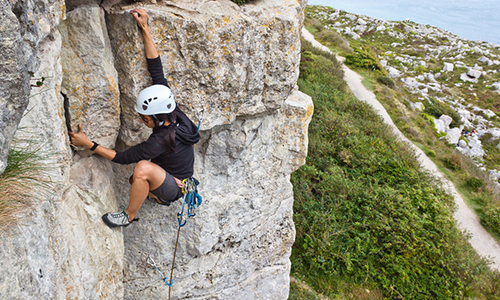How to Prevent Injuries While Climbing
Author

Chris shares his passion for cycling, hiking, skiing, and climbing from Buxton, in the Peak District. As a blogger for Outdoor Look, Chris shares outdoor tips and indoor tricks to help you get the most out of your time spent outside. When he's not out adventuring he's making videos or trying to keep up with his 4-year-old son.
 Those who are fitness enthusiasts and want to increase their stamina and overall strength, choose rock climbing as their most important workout activity.
Those who are fitness enthusiasts and want to increase their stamina and overall strength, choose rock climbing as their most important workout activity.
However, the adventure sport is a lot more dangerous than it looks and therefore necessary precautions have to be taken into consideration before you step out to experience the adventure. Here are several tips and techniques that can help you avoid injuries while climbing:
Develop Antagonist Muscles in Your Body
Try to strengthen the upper arms, chest and shoulders so that to create a balance between the upper and lower body strength. Generally, while climbing, the body pulls energy from the lower part of the body. This makes the upper body useless as it does not have anything to pull or push, making you more susceptible to having an injury. Do exercises that strengthen the upper body, but to an extent where the body feels the strain, causing the muscles to gain strength.
Wrists, Hands and Fingers
Pulling is also helpful when climbing because it takes away the load from your legs and gives your upper body a workout. Fingers, hands and wrists are very crucial for pulling. The most important gripping technique is the Metolius Grip Saver. This technique helps pull the fingers upwards against the resisting force, giving you a chance to rest your legs and building up your upper body strength.
Shoulder
Work on your shoulders with exercises that help extend shoulder muscles, assisting you to counter the pulling action requirement while climbing. Stand in front of the wall with your face towards it and extend your arms straight upwards and behind for a period of 10 to 30 seconds. Push-ups and triceps exercises will also help you gain strength in your shoulders, helping you avoid injuries while climbing.
Elbows
 Tendon strength is important for prevention of tennis elbow or golfer’s elbow. Also, exercises that help improve tendon strength can help rehabilitate tennis and golfer’s elbow injuries. Holding a handle in vertical position with the entire weight focused on top and keeping the hand at the bottom, one has to slowly turn their thumb towards themselves and lower the weight 90 degrees horizontally for five seconds. The other hand has to be used to lift the handle back to the initial point. This exercise will help work the tendon and not the muscle. The exercise is helpful to prevent tennis elbow or can heal those with tennis elbow. For golfer’s elbow the same process has to be repeated, but the handle has to be rotated 90 degrees in the other direction and the thumb has to be turned away from the body.
Tendon strength is important for prevention of tennis elbow or golfer’s elbow. Also, exercises that help improve tendon strength can help rehabilitate tennis and golfer’s elbow injuries. Holding a handle in vertical position with the entire weight focused on top and keeping the hand at the bottom, one has to slowly turn their thumb towards themselves and lower the weight 90 degrees horizontally for five seconds. The other hand has to be used to lift the handle back to the initial point. This exercise will help work the tendon and not the muscle. The exercise is helpful to prevent tennis elbow or can heal those with tennis elbow. For golfer’s elbow the same process has to be repeated, but the handle has to be rotated 90 degrees in the other direction and the thumb has to be turned away from the body.
Climbing Technique
Rather than hanging of the bones one should use their shoulder muscles. Use crimping with your open hand as the closed hand crimping puts pressure on the A2 pulley and the joints. Keep your arms straight and elbows low, wherever possible. Avoid keeping your arms bent or chicken wing shaped as it will put a lot of pressure on the shoulder tendons. Also, keeping the arms high will put pressure on the triceps muscle. Use the core muscles and the legs to climb, preventing the injury prone body parts of be safe, i.e. shoulders, fingers and arms.
Other than the technique a lit bit of static stretching or yoga before and after climbing will do wonders in relaxing your body from the tension all the muscles in your body had to endure. Also, proper relaxation should be practised after you are done climbing, as there could be some chronic injuries that you would not know immediately about.
Author

Chris shares his passion for cycling, hiking, skiing, and climbing from Buxton, in the Peak District. As a blogger for Outdoor Look, Chris shares outdoor tips and indoor tricks to help you get the most out of your time spent outside. When he's not out adventuring he's making videos or trying to keep up with his 4-year-old son.
- Speed Up Your Post-Hike Recovery with These 6 Essential Tips
- Cycling through Tranquil Roads and Coastal Views on the Isle of Wight
- The Essential Guide to Hiking Safety: 5 Tips Every Hiker Should Know
- Run Smart, Run Strong: Your Guide to Injury-Free Running
- Embrace Biking: Essential Tips for Beginners
Categories
- Sport (28)
- Product Reviews (3)
- Team Outdoor Look (7)
- Mike Wild (2)
- Mike Payton (2)
- Suse Hammond-Pears (3)
- Snowboarding (12)
- Latest Offers (105)
- Shop Talk (1)
- Competitions (7)
- Walking (413)
- Lifestyle Fashion (8)
- Travel (86)
- Kit Guides (176)
- Workwear Clothing (6)
- Safety Workwear (4)
- Health/Fitness (289)
- Skiing (91)
- Great Outdoors (1316)
- Cycling (92)
- January 2025
- December 2024
- November 2024
- October 2024
- September 2024
- August 2024
- July 2024
- June 2024
- May 2024
- April 2024
- March 2024
- February 2024
- January 2024
- December 2023
- November 2023
- October 2023
- September 2023
- August 2023
- July 2023
- June 2023
- May 2023
- April 2023
- March 2023
- February 2023
- January 2023
- December 2022
- November 2022
- October 2022
- September 2022
- August 2022
- July 2022
- June 2022
- May 2022
- April 2022
- March 2022
- February 2022
- January 2022
- December 2021
- November 2021
- October 2021
- September 2021
- August 2021
- July 2021
- June 2021
- May 2021
- April 2021
- March 2021
- February 2021
- January 2021
- December 2020
- November 2020
- October 2020
- September 2020
- August 2020
- July 2020
- June 2020
- May 2020
- April 2020
- March 2020
- February 2020
- January 2020
- December 2019
- November 2019
- October 2019
- September 2019
- August 2019
- July 2019
- June 2019
- May 2019
- April 2019
- March 2019
- February 2019
- January 2019
- December 2018
- November 2018
- October 2018
- September 2018
- August 2018
- July 2018
- June 2018
- May 2018
- April 2018
- March 2018
- February 2018
- January 2018
- December 2017
- November 2017
- October 2017
- September 2017
- August 2017
- July 2017
- June 2017
- May 2017
- April 2017
- March 2017
- February 2017
- January 2017
- December 2016
- November 2016
- October 2016
- September 2016
- August 2016
- July 2016
- June 2016
- May 2016
- April 2016
- March 2016
- February 2016
- January 2016
- December 2015
- November 2015
- October 2015
- September 2015
- August 2015
- July 2015
- June 2015
- May 2015
- April 2015
- March 2015
- February 2015
- January 2015
- December 2014
- November 2014
- October 2014
- September 2014
- August 2014
- July 2014
- June 2014
- May 2014
- April 2014
- March 2014
- February 2014
- January 2014
- December 2013
- November 2013
- October 2013
- September 2013
- August 2013
- July 2013
- June 2013
- May 2013
- April 2013
- March 2013
- February 2013
- January 2013
- December 2012
- November 2012
- October 2012
- September 2012
- August 2012
- July 2012
- June 2012
- May 2012
- April 2012
- March 2012
- February 2012
- January 2012
- December 2011
- November 2011
- October 2011
- September 2011
- August 2011
- May 2010
- April 2010
- March 2010
- February 2010
- January 2010
- November 2009
- October 2009
- September 2009
Submit a Comment